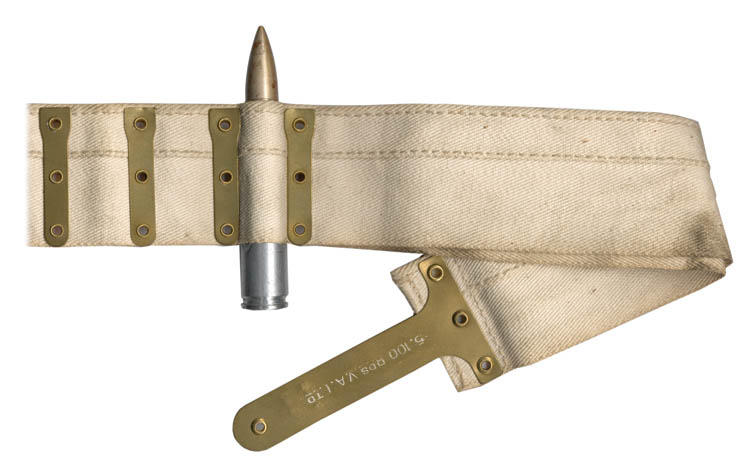
This article is intended to complement Anthony Williams’ article published in last month’s SAR (Vol. 15, No. 4, January 2012) dedicated to .5-inch Vickers guns and ammunition in order to present some of the feed systems used with those weapons. Both fabric belts and metal disintegrating links are presented for four main types of .5-inch Vickers ammunition, namely the earliest belted .600/.500-inch, the rimless 12.7×81, the semi-rimmed 12.7x81SR and the high velocity semi-rimmed 12.7x120R.
Feeding the Early Vickers in .600/.500-inch
Early .5-inch aircraft Vickers machine guns used the belted .600/.500-inch cartridge. The feeding was achieved by means of a complex and over-engineered disintegrating metallic link using no less than 5 separate rings. The ammunition itself is nowadays an extremely sought after specimen and only available in the world’s most advanced collections. The known surviving links are only a handful nowadays and are probably among the scarcest British disintegrating link for collectors.
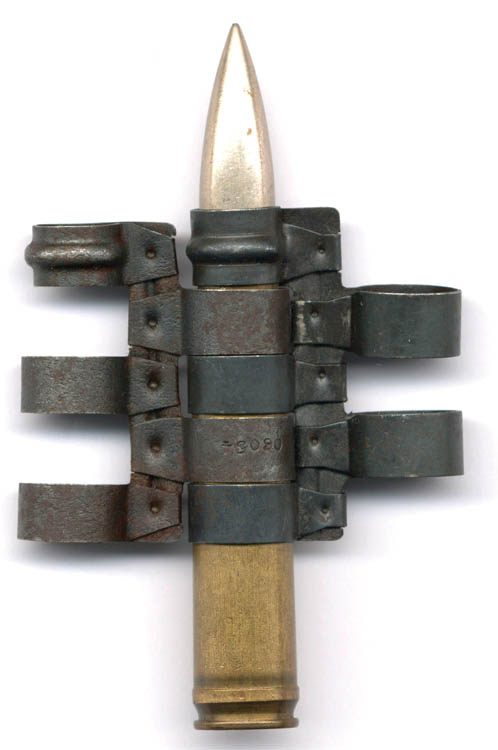
Feeding the British Service .5-inch Vickers for the Rimless 12.7×81
The rimless 12.7×81 Vickers ammunition was adopted for British Service in 1924 and is also referred to as the .5”V/580. This ammunition was used in British Service both on Land, Sea and in the Air.
Land Service .5-inch Vickers
On Land, the Mark II, IV and V water-cooled tank guns were fed with a 100-round fabric belt referenced as Mark I. The belt is composed of two strips of cotton fabrics assembled together with riveted brass spacers. Both ends of the belt are fitted with a brass starter tang intended to facilitate the introduction of the belt into the feed block. The starter tangs are marked with the caliber designation, the belt capacity and the manufacturer’s code. One starter tang only also bears inspection markings. The brass spacers are slightly chamfered at the top ends in order to positively seat the shoulder of the cartridge case in the belt. Before World War 2, belts are produced by the company Vickers-Armstrongs Limited and are not dated. During World War 2, belts are produced by the company Thomas French & Sons of Manchester. This company specialized in the production of a very wide range of belts and links in various calibers. These wartime belts by Thomas French are marked with month and date of production.
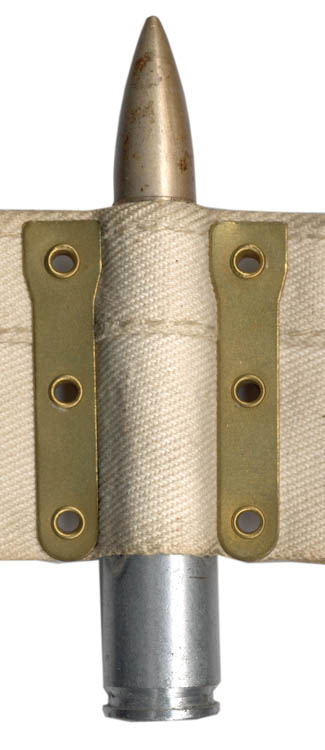
Detail of the seat of the .5-inch Vickers cartridge in the Mark I fabric belt. Note the chamfered top ends of the brass spacers, which fit on the cartridge case shoulder. 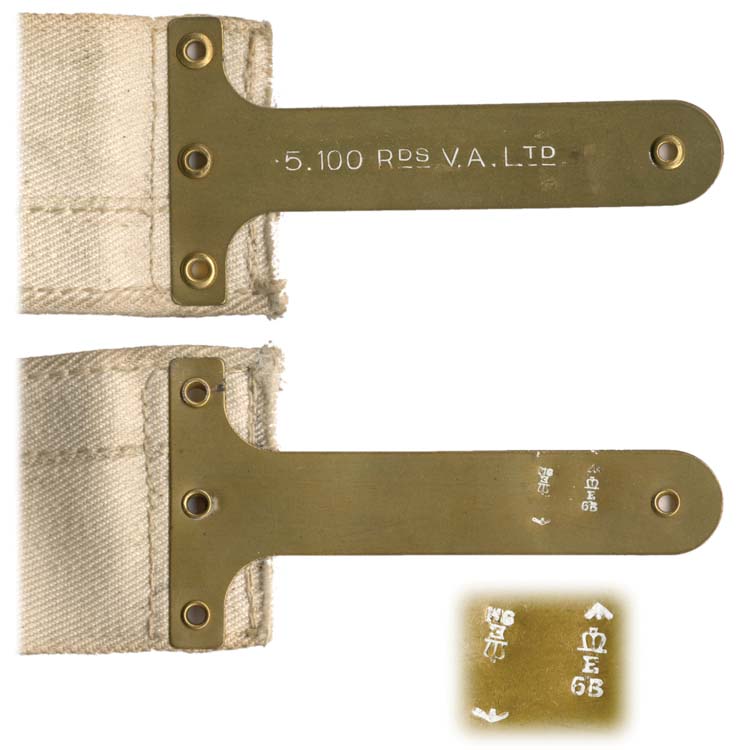
Detailed view of markings of one of the starter tang on a pre-WW2 Mark I belt manufactured by Vickers-Armstrongs limited. 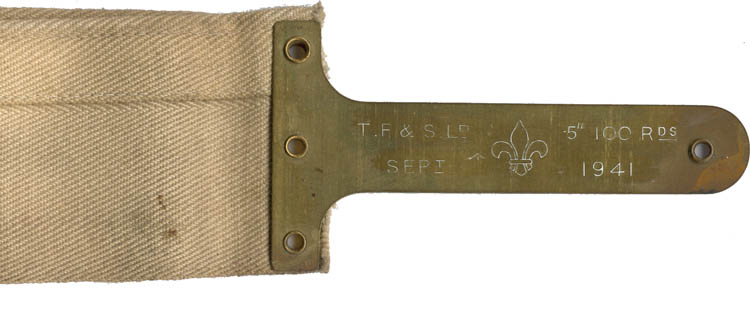
Detailed view of the starter tang dated September 1941 by Thomas French & Sons.
Naval Service .5-inch Vickers
The water-cooled naval Mark III .5-inch Vickers weapons, most frequently encountered on the quadruple Mark M anti-aircraft mount are fed with a 200-round belt assembled with metallic disintegrating links and wrapped around a spool.
Two types of links were in service. The standard link is of the model Mark II Navy and denoted II N. The link design is a direct scale-up version of the Prideaux links developed by the inventor during WW1 for the .303 Vickers aircraft weapon. The links are marked with the weapon designation .5VMG or .5MG, the model of link II N and the manufacturer’s code. According to the large amount of links used during WW2, at least nine different British manufacturers produced those Mark II N links. For example, the company British Pens Limited of Birmingham (marking BP) produced 14,198,000 Mark II N links during WW2.
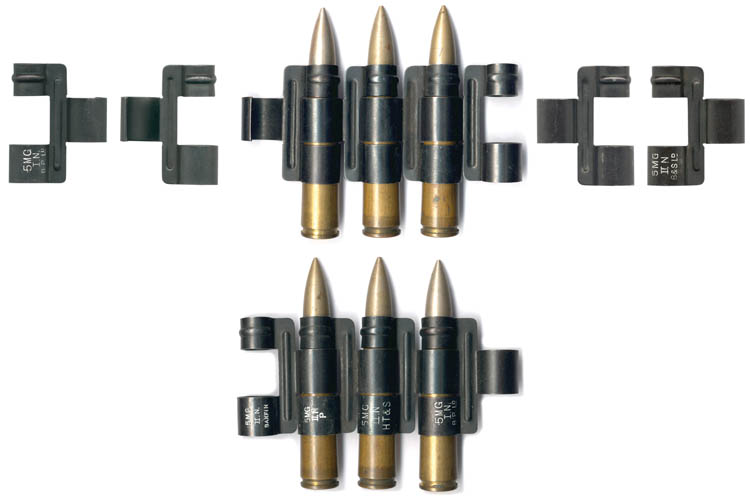
With the standard Mark II N links, the connection of belt sections with one another usually requires that a loose cartridge be inserted into the trailing links of each belt. In order to enable the connection of two belt sections together without the need to remove and insert a cartridge, a dedicated connecting link was designed and referenced Connecting Link Mark I Navy and denoted I N. This link is fitted with a half-open central loop which can be directly snapped into the last cartridge of the adjacent belt. This connecting link is marked with the weapon designation .5MG, model of link I N and manufacturer’s code. According to their specific use, these connecting links were produced in a much smaller quantity than the standard Mark II N links. It is suspected that probably only very few manufacturers produced these joining links. So far, the author has only come across Mark I N Connecting Links manufactured by the company British Pens Limited (BP), but there are probably other productions.
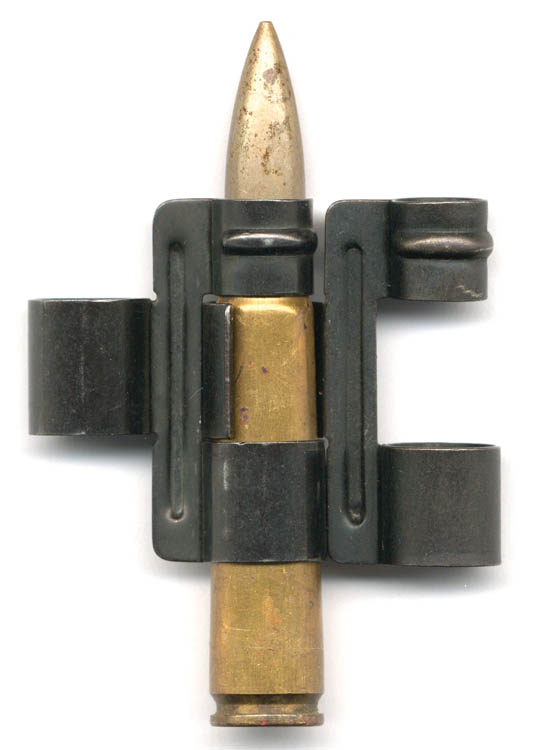
Air Service .5-inch Vickers
The .5-inch Vickers was involved in British Air Service with the air-cooled Vickers Class B weapons. Only very few weapons were actually acquired by the British War Office for test purposes. These aircraft weapons were fed with simplified and lightened disintegrating links. These Class B links are nowadays rarely encountered.

Feeding Weapons for the Semi-Rimmed Export 12.7x81SR Vickers Ammunition
According to the British War Office requirements, the Vickers Company was only permitted to export .5-inch weapons using a slightly modified cartridge case to make it semi-rimmed which makes it 12.7x81SR. The Vickers designation of that ammunition was .5”V/565.
Vickers exported a few tens of aircraft weapons chambered for that caliber to Japan and Siam. The disintegrating links used with those exported weapons have not been definitively identified. It is however suspected that the links are the same as those used with the Class B aircraft weapons but this is only speculation pending documented evidence.
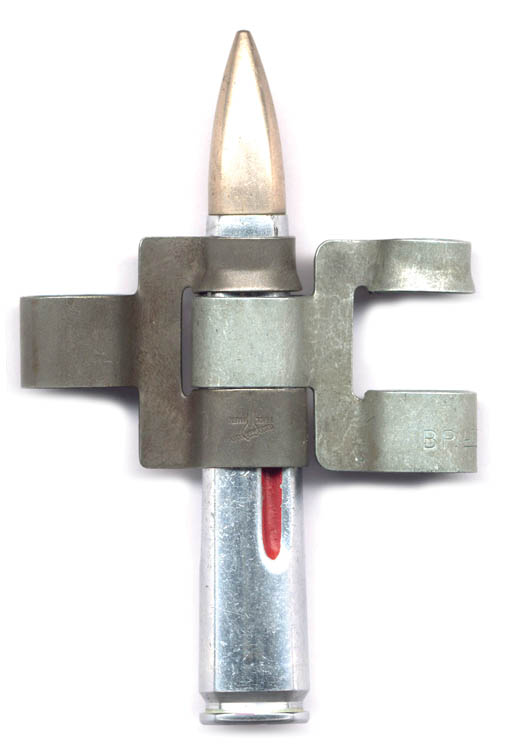
Feeding Italian Weapons in 12.7x81SR
Italy adopted the semi-rimmed cartridge 12.7x81SR for their aircraft weapons of domestic design.
The Breda-SAFAT aircraft weapons are fed with disintegrating links of the Prideaux design similar to those used with the British Mark III Naval weapons. Italian made links can be readily identified by the markings exhibiting the Italian manufacturers’ code and the month and year of production. No connecting link was used by Italy. It is not known to the author whether Hungary domestically produced any links to feed their Breda-SAFAT.
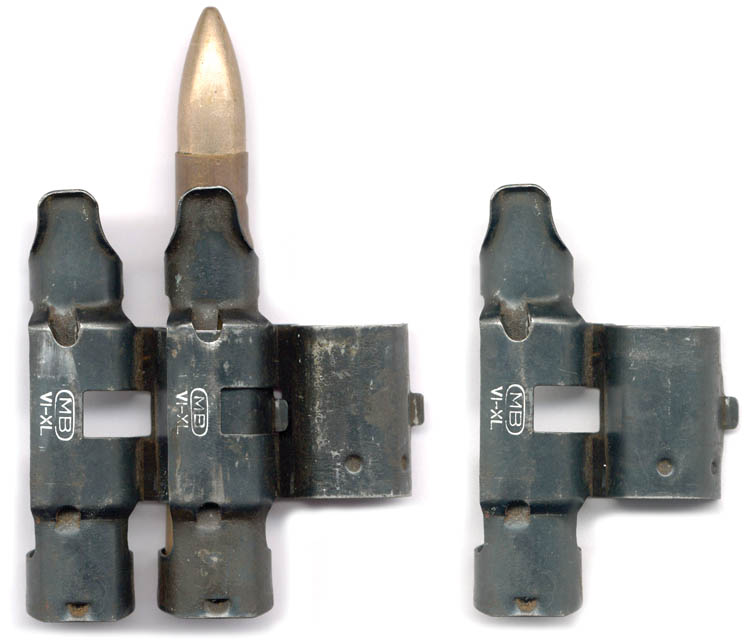
The other major Italian aircraft weapons chambered for 12.7x81SR is the Scotti-Isotta Fraschini, which also uses disintegrating links. This weapon uses a feed mechanism where the cartridge is pushed through the links that therefore requires belt links of specific design.
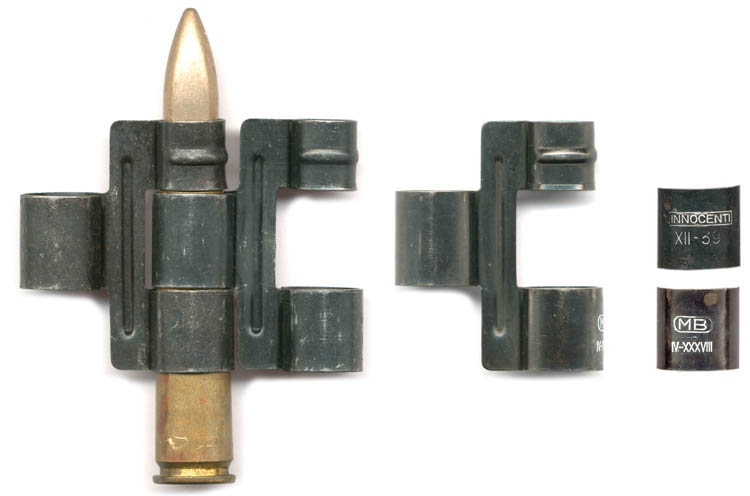
Specimens of Italian push-through links with “hook-and-eye” connection design are known from surviving specimens bearing the markings Mod. 42. It is currently unknown to the author whether these are a late variant of links for the standard Scotti weapons or specific links for another weapon. Any comments by readers would be most appreciated.
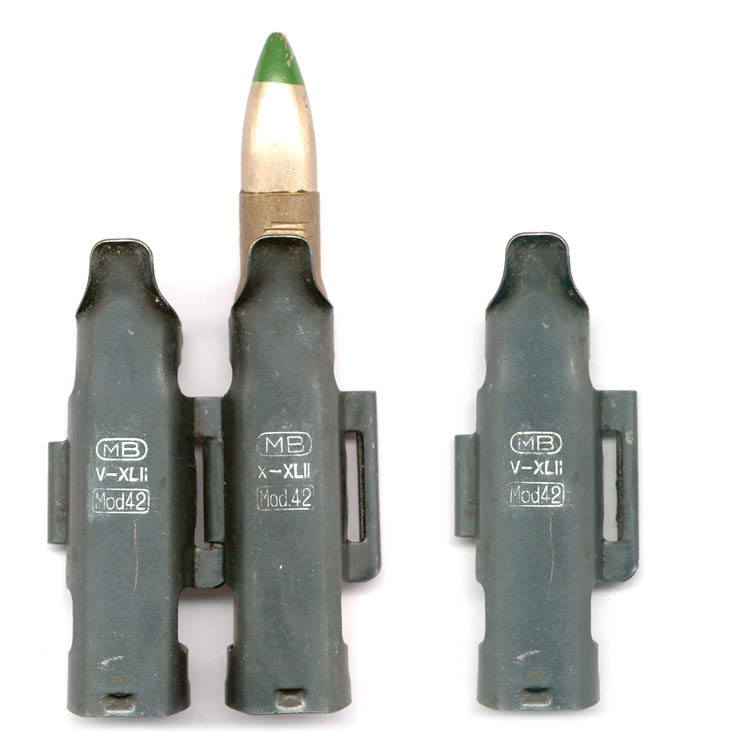
Feeding Japanese Weapons in 12.7x81SR
Japan adopted the semi-rimmed 12.7x81SR cartridge to feed the Ho-103 aircraft weapon that was derived from the U.S. .50 cal. Browning. The feeding is achieved with disintegrating links which, unsurprisingly, are derived from the U.S. Browning .50 cal. Links M1. Japanese links are either unmarked or marked with the manufacture’s logo.
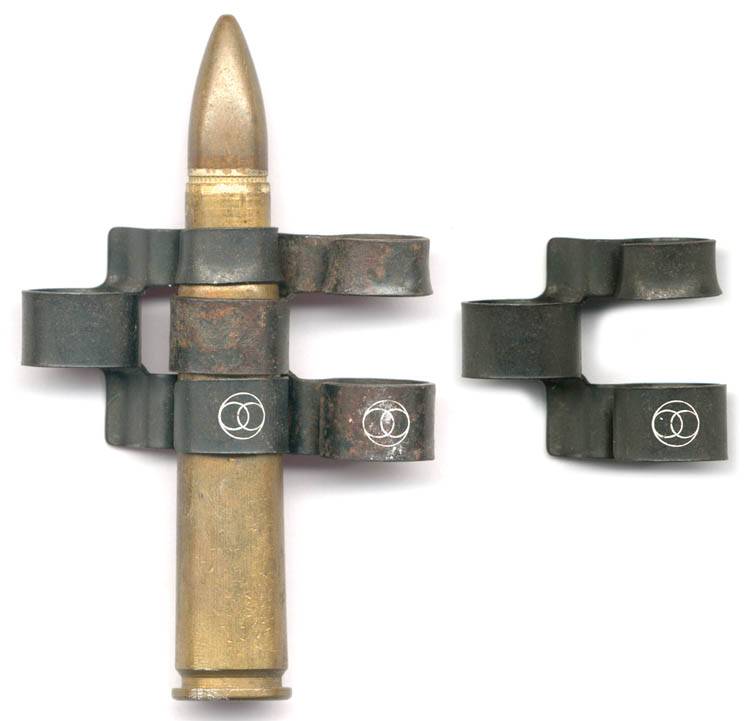
Feeding the High Velocity Vickers Class D for Semi-Rimmed 12.7x120R
The water-cooled High Velocity Vickers Class D chambered for 12.7x120SR was fed with disintegrating links. This weapon was never adopted by Britain and only very few specimens were sold to Asian countries. Accordingly surviving specimens of the links are nowadays rarely encountered. Links observed so far are unmarked.
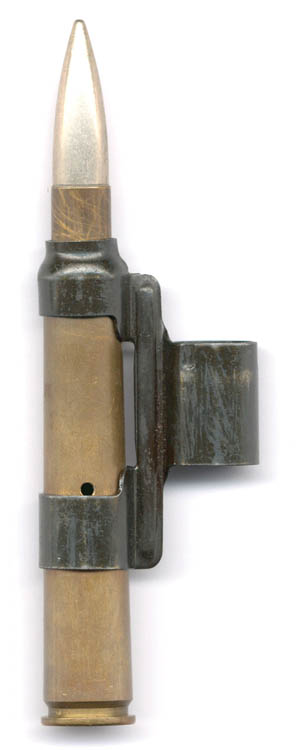
| This article first appeared in Small Arms Review V15N5 (February 2012) |











